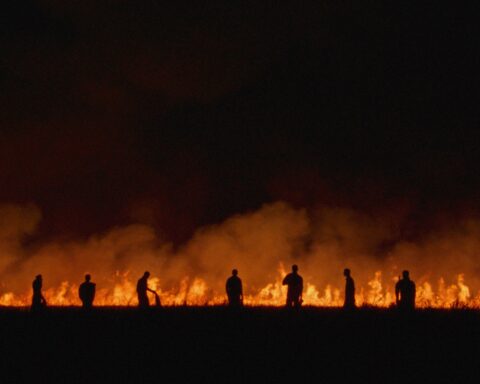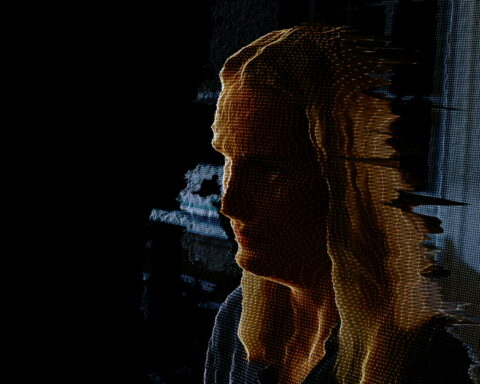What Remains, Steve Cantor’s documentary on photographer Sally Mann, is a stunningly beautiful, courageous film. Set in the American South, mostly on the Mann’s family farm in Lexington, Virginia, it encompasses her surroundings and ambitious new plan to develop a series on body, spirit and the return to land. Cantor has depicted the oeuvre of a photographic artist whose early work was sensationalized as child pornography and recent explorations of mortality, death and decomposing human and animal bodies is clearly controversial. _What Remains_ took nearly four years to complete, during which time Cantor and his crew followed Sally Mann’s creative process. Cantor is pleased to point out that Mann is “really good at extracting the meaning out of her work.”
Husband Larry Mann and their three children, now young adults, participated in the photo series, also titled What Remains, and the doc. Cantor’s incisive film features various photo sessions with Mann and interviews with her family about what it’s like to be “documented” by your mother and life partner. As Larry says, “Sally has had a camera in her hand since I met her. She sees the world in images.”
In the opening frame of the documentary Mann states, “The things that are close to you are the things you can photograph the best. Unless you photograph what you love, you are not going to make good art.” The inspiration for her photo series started at the farm in December 2000, when an escaped prisoner ended up on Mann’s property and shot himself on her land. The incident deeply affected Sally Mann and instigated a series of questions: What happens to the land when someone dies on it? What happens to the earth? Is there a memory created? Sally Mann says, “she watched the earth take a sip of his blood. The earth, with all of its power, won’t remember, but the artist will.”
{image_1}
In recent years, Larry Mann was diagnosed with multiple sclerosis, a fatal illness which will cause his muscles to gradually atrophy. Cantor says: “I’m sure that is what propelled Sally to do this series on death and mortality.” Larry Mann’s illness is discussed in the film, with his pain-racked body on display for audiences to see. Cantor comments, “I told them if we are going to do this film, everyone participates, and nothing is held back. They all agreed.”
Such cooperation is rare between a filmmaker and his subjects but Cantor is no stranger to the Manns. This is the second time that the tall, curly-haired Cantor has been given access to Sally Mann’s home, art-making and psyche. In 1994, he made a short, _Blood Ties_, which documented her _Immediate Family_ photography series. Mann’s images of her nude husband and pre-pubescent children had gained her notoriety and controversy. She ended up on the cover of Time Magazine as Photographer of the Year despite being vilified in conservative circles as a child pornographer.
When Cantor first met Mann, he had recently graduated from Colgate University, a small upstate New York liberal arts college, and was a segment producer for a news magazine show on MTV. “I wanted to do something more substantial and thought I would make a film about artists and censorship. This was during the time of the Robert Mapplethorpe scandal,” says Cantor. “I’d heard about Mann’s work and wanted to include her in my film. I drove to her idyllic Virginia farm. I looked at her kids, so beautiful, so precocious. I looked at her art and I had never had such an emotional response. She was so truthful and it was such a beautiful display of what childhood is all about.” _Blood Ties_ went on to receive many accolades including an Academy Award nomination and was an official entry at the Sundance Film Festival.
In 1998, Cantor founded Stick Figure Productions, a New York-based independent company. It has produced a number of award- winning documentary films including Devil’s Playground; Willie Nelson: Still is Still Moving and Bounce: Behind the Velvet Rope as well as the critically acclaimed real life series Family Bonds (for HBO). Through the making of Blood Ties, Cantor and Mann developed a strong friendship.
Cantor says they are in touch on a weekly basis. “There is a school of filmmaking, cinema verité, that says you should not get involved in your subjects’ lives at all. You should be a fly on the wall, and no matter what their financial hardship, or missing child, you should just not participate. I don’t really subscribe to that. It’s the cinematic style of filming that I like. That’s my approach to documentaries, and I tend to get pretty involved.”
The lanky thirty-something Cantor continues, “Blood Ties was my first attempt at a film and because it was my first, I didn’t really love it. It focused too much on the controversy and in the intervening years, I have gotten to know Mann much better. She has such a good understanding of her process and that is really rare. The earlier film didn’t show anything about how she extracted meaning in her work. This film was made to do what the earlier film did not. It was sort of like a monkey on my back.”
In _What Remains_, we follow Sally Mann as she records shots of her beautiful land, children and husband, the corpse of one of her beloved dogs and decomposing bodies. “Until you actually set up the camera, it is so funny, you don’t actually see the work. You look into the camera and then, what was just a feeling suddenly turns into a photograph. It’s the oddest phenomenon,” she comments.
Whether it’s Larry Mann on one of the farm horses, a textured tree-scape, or a close up of one of the children’s faces, her images have a spiritual look, a haunting “other world” aura. Her work, while conceptually very modern, takes on the kind of feel of 19th century photography such as that of Victorian Julia Margaret Cameron.
Mann generally carries heavy equipment, usually a large format 8×10 camera and tripods. For this series, she mastered the wet-collodion process, a practice used in 19th century photography, and the resulting photos look like they are from that era. Chemicals are poured onto large glass plates. Mann likes to use chipped lens and glass with slight imperfections thereby allowing layers of light, resulting in an almost painterly appearance.
Mann needed and got permission to visit a forensic lab that studies decomposing bodies. The film crew followed her as she examined the bodies and set up shots. Cantor notes that the access approval was very complicated. “And it was so nauseating, the pungent sulphuric and disgusting smell. It gets lodged in your throat and stays there for days. But at the same time, looking at these bodies was just so beautiful and natural, like roots to the ground. The ground is absorbing the dead and there is something just so reassuring and peaceful about it.”
Only a few months before Mann’s planned exhibition, an unexpected change occurred. The Pace Gallery, New York City’s prestigious blue chip commercial gallery had a studio preview and cancelled her show. Mann was devastated and Cantor’s camera rolled as she broke down and cried with disappointment. She figured they were worried that the work was too difficult, too macabre for a commercial success. Mann eventually rallied to find another venue for her work. But she wondered, “Who should we get to sponsor? The Grim Reaper?”
Ultimately, the Corcoran Gallery in Washington D.C., agreed to exhibit _What Remains_ and the show was a critical success. It was a massively ambitious installation, with over 90 new photographs. Mann created five sections, including the decomposition of one of her dear pets, a greyhound; a series of human bodies decomposing; two sections on land and landscapes; and another section with 36 tight close-up portraits of her three children’s faces, staring out to the viewer. Reactions were very strong and Mann was pleased with the outcome.
What Remains wraps with a sequence in Mann’s studio when she and Cantor literally turn the camera onto her. She posed for a portrait, Cantor’s camera lens pulled in closely. She lay in front of the camera, eyes not moving, for several minutes. With voiceovers, the film finished with dozens of images from Mann’s portfolio, as her life’s work flashed in front of her face. It’s a perfect collaborative ending between two artists, Mann and Cantor.
In addition to several film festivals, BBC recently aired the film and HBO will show What Remains in the fall. However, Cantor has been having trouble getting film distribution. “Everyone’s ‘we really like the film but the naked children and dead people are not going to pack the theatres.’ It’s the most natural thing in the world. Yes, it’s difficult material, but it is also about an intimate discovery of process, life and death.”
What Remains is many things: a brilliant film and photography series, a devastating photo exhibit and a clever portrait of a talented and sensitive artist who puts her family, her surroundings and life’s journey, to incredible scrutiny.











